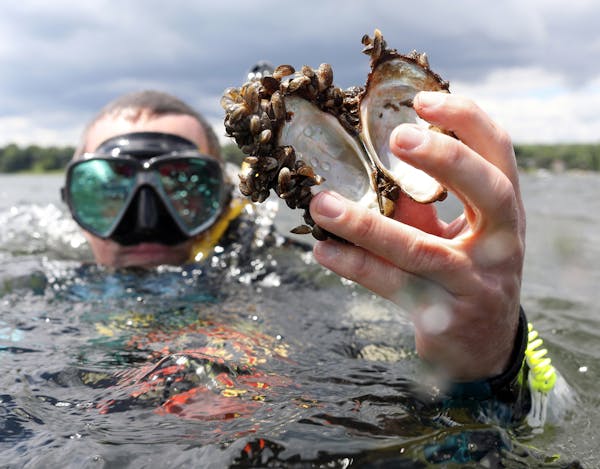After years of meticulous research, scientists at the University of Minnesota have mapped the genome of the zebra mussel, unlocking endless possibilities to combat, control and learn from the invasive mussel that has taken hold throughout the Great Lakes region.
The map, pieced together from hundreds of millions of lines of genetic code, will allow researchers to pinpoint the exact genes that have allowed the mussel to thrive while upending the ecology of lakes not just across Minnesota and North America, but in Europe as well.
Those genes could also provide clues, researchers hope, to weaknesses that could be exploited to collapse mussel populations, slow or stop their spread and limit their damage to lake ecosystems.
"This was the first step," said Nick Phelps, director of the U's Minnesota Aquatic Invasive Species Research Center. "We don't know yet quite where to attack. But now there's a whole spectrum of strategies that can be considered."
The genome sequence could make it possible to find ways to genetically modify zebra mussels in a way that could slash their populations here, Phelps said. That could mean manipulating their genes so they essentially self-destruct — destroying their ability to reproduce, or grow shells, or produce the adhesive they need to cluster and attach to boats, docks and lake beds.
It could also greatly improve more conventional control methods such as chemical treatments, said Daryl Gohl, one of the lead authors of the genome project.
"There are a lot of insights ... from the genome that don't rely on modifying the species," Gohl said. "It's really about understanding the basic biology of how they have thrived and finding any weaknesses that can be exploited."
Authors have provided the entire genome sequence to Biorxiv ("Bio-archive''), an online archive and publisher of life sciences research. The work is under peer review and available to scientists around the world.
Zebra mussels traveled to the United States from the Caspian Sea in Eastern Europe, in the ballast water of ocean freighters, and first took hold in Lake Erie in 1988. They spread through the Midwest almost immediately.
Once established, they kill or out-compete native mussels. They're highly effective filters, sucking out and consuming the nutrients and smallest edible material in a lake, robbing minnows and native organisms of essential food. They also produce razor-sharp shells that can make beaches and lake fronts unusable, while excreting a carpet of waste that produces toxic algae.
They form such thick clusters that they can clog up pipes and drains, causing cities across Minnesota to spend millions of dollars a year installing screens and scraping them out of drinking water supplies.
While it has proved nearly impossible to even slow the spread of zebra mussels, they do have potential weaknesses, said Michael McCartney, a lead author.
The mussels, for example, were never able to thrive in Lake Superior in the same way they dominated the other Great Lakes, he said. The zebra mussels that do survive in Superior tend to have extremely weak, paper-thin shells that are filled with ulcers.
That could be, in part, because Superior has lower calcium levels than the other lakes, McCartney said.
"No one knows exactly why this weakness exists, but now if we can find the basic biology — the genes responsible for hardening their shells — one day maybe we could exploit that or make them even weaker," McCartney said.
Amazing adhesive
Researchers aren't just interested in the mussels' weaknesses, but in their strengths as well.
In the same way that scientists are using genetic research to understand and replicate how spiders spin such perfect silk, the University of Toronto's school of dentistry has been working with the U to find out how zebra mussels produce such a powerful waterproof glue, McCartney said.
Zebra mussels produce the strongest adhesive of any known mollusk. "You try to learn from nature about these materials," he said.
Gohl said, however, that any decisions on genetic modification should not be taken lightly and are likely years away.
"It requires a lot of consultation with the community and stakeholders," he said. "It's something we as a society need to decide as this technology improves."
Genetic modifications are attractive for invasive species largely because they have the potential to be more effective and safer than other control methods, said Michael Smanski, an assistant professor in the U's College of Biological Sciences.
The genome sequence makes it possible to target a single species in a way that chemical pesticides and poisons might never accomplish, he said.
"You basically take that invasive organism and engineer it so it becomes the pesticide," Smanski said.
Carlos Carrasco pitches solid into the 6th inning, Guardians edge Red Sox 5-4 to improve to 13-6

Live: Wild wrap regular season vs. Seattle, follow on Gameview
Kansas adds AJ Storr after he led Wisconsin in scoring this past season

